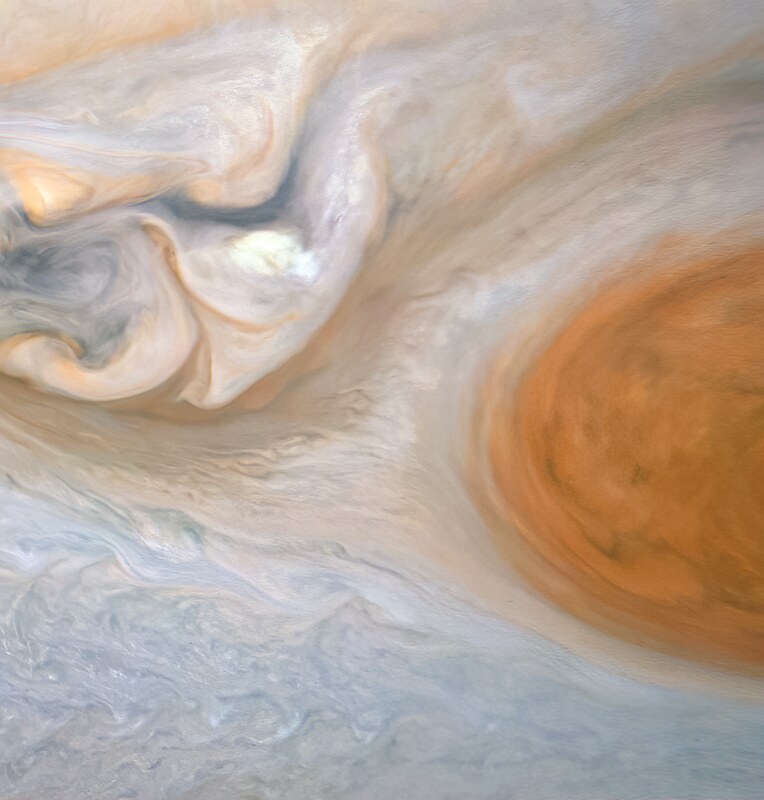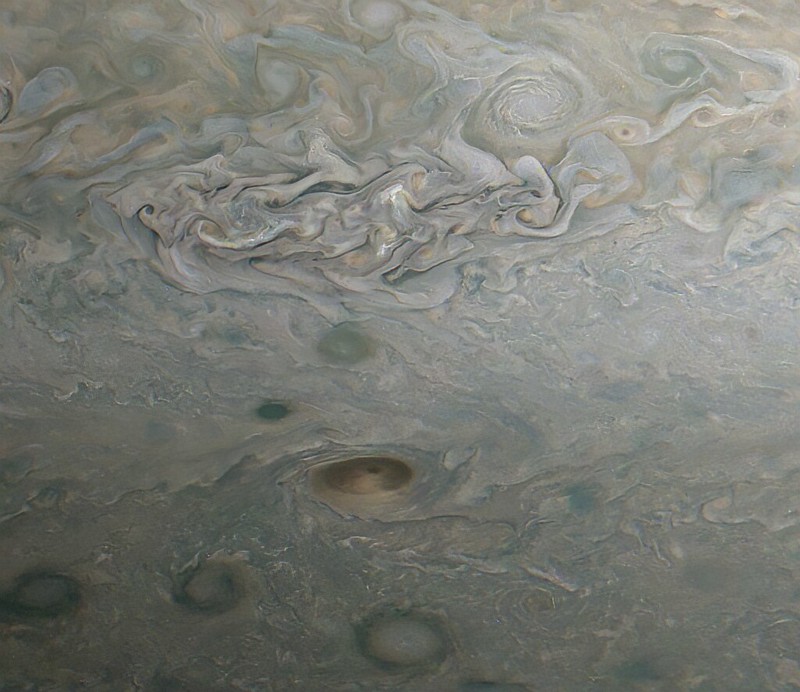Full Version: Juno Perijove 31
We've started getting images back from PJ31, but I'm not sure when they'll show up on missionjuno due to the holiday schedule.
First nine PJ31 images on missionjuno.
Draft renditions of the first 14 images are online, including the five red lightning search images.
Here is a crop of a draft rendition of #10 showing a CPC with a potential lightning candidate:
Click to view attachment
Two reprojections with gamma=4:
#12:
Click to view attachment
Click to view attachment
Two reprojections with gamma=4:
#12:
Click to view attachment
We seem to be lucky enough to see the north polar cyclone being displaced from the pole by about one degree towards the day side:
Click to view attachment
Click to view attachment
As a matter of curiosity, which values are you (and others here) using for Jupiter's equatorial and polar radius when reprojecting the JunoCam images? I'm using the 'official' values (71492 and 66854 km for the equatorial and polar 1 bar level) but have been seriously considering experimenting with modifying these values slightly.
The altitudes of the highest clouds should be approximately 20 km above the 1 bar level. I'm not doing any rendering or projection of Juno images to confirm that that value would make for a better image product.
Usually, I'm using the official IAU spheroid. Sometimes, I add 100 km whenever I want to ensure that the limb isn't cropped for whatever purpose. But I have degrees of freedom regarding the pointing. This time, I modified the pointing more than usual to get a reasonable limb fit, potentially due to the applied SPICE trajectory, including pointing of the s/c rotation axis, being preliminary, or by a degenerate geometry. However, the resulting map renditions were consistent up to one or two pixels near the pole for maps with a resolution of 60 pixel per degree. So, I didn't see a requirement for further adjustment.
But I'm aware of systematic errors, which I didn't fix yet. The IAU spheroid is inaccurate due to varying cloud heights and due to the zonal winds inducing a deviation of up to ~40 km. (Last time I looked for the best fit equipotential model, the data haven't been released publicly, yet. But the equipotential can be derived from published spherical harmonics.) I also don't adjust systematically for velocity aberration, which may result in errors up to about 3 or 4 pixels. There may also exist longitudinal deviations from a spheroid. In my eyes, such systematic adjustments don't make too much sense, since the uncertainty of the cloud or haze height can be several 10s of km, too, and require manual or semi-automatic adjustments in any case.
But I'm aware of systematic errors, which I didn't fix yet. The IAU spheroid is inaccurate due to varying cloud heights and due to the zonal winds inducing a deviation of up to ~40 km. (Last time I looked for the best fit equipotential model, the data haven't been released publicly, yet. But the equipotential can be derived from published spherical harmonics.) I also don't adjust systematically for velocity aberration, which may result in errors up to about 3 or 4 pixels. There may also exist longitudinal deviations from a spheroid. In my eyes, such systematic adjustments don't make too much sense, since the uncertainty of the cloud or haze height can be several 10s of km, too, and require manual or semi-automatic adjustments in any case.
As a matter of curiosity, which values are you (and others here) using for Jupiter's equatorial and polar radius when reprojecting the JunoCam images?
I'm currently using the defaults. Didn't see benefit when I experimented with using larger values (but my pipeline's limb fitting and processing isn't particularly sensitive to radius.)
As a matter of curiosity, which values are you (and others here) using for Jupiter's equatorial and polar radius when reprojecting the JunoCam images? I'm using the 'official' values (71492 and 66854 km for the equatorial and polar 1 bar level) but have been seriously considering experimenting with modifying these values slightly.
seeing as isis3/4 defaults to equatorial , that is what i am using .
i added the polar radius , at one point , but i did not see any difference .
Someone at missionjuno is working this weekend. More raw data there today. PJ31 is looking great.
Here is reduced resolution exaggerated color/contrast collage of what's there so far.
Click to view attachment
Here is reduced resolution exaggerated color/contrast collage of what's there so far.
Click to view attachment
Part 2, drafts, reprojections roughly illumination-adjusted stretched to gamma=1, and gamma=4 relative to radiometric values. Resolution is about that of the camera.
Note a moon rising over the GRS in the drafts of #31 to #33.
Note a moon rising over the GRS in the drafts of #31 to #33.
Io is coming in the next batch just for you, Jason! May be out there already.
Yeah, Kevin Gill and I were just talking about them on Twitter. No plumes, though the only plume site on the limb or on the terminator was Chalybes on the bright limb.
I am encouraged to see that JunoCAM is picking up Jupitershine pretty well. Makes me even more excited for the Io flybys.
Two individual crops of PJ31, #034 and #036, drafts to Io
Click to view attachment Click to view attachment
(from drafts, part 3)
and a stack of both
Click to view attachment
---
Here a condensed view of Jupiter's limb, PJ31, #020, to show how rapidly the hazes and hence the limb or apparent radius of Jupiter can change:
Click to view attachment
Click to view attachment Click to view attachment
(from drafts, part 3)
and a stack of both
Click to view attachment
---
Here a condensed view of Jupiter's limb, PJ31, #020, to show how rapidly the hazes and hence the limb or apparent radius of Jupiter can change:
Click to view attachment
Nice work! I think there's a hint of surface detail in the jupitershine side of Io, but it's subtle.
Extended mission has been approved?
I've not seen any mention of this.
I've not seen any mention of this.
And a few marble composites:

Jupiter - PJ31 - Composite - 35 - 2

Jupiter - PJ31 - Composite - 37 - 3

Jupiter - Perijove 31 - Composite\

Jupiter - PJ31 - Composite - 35 - 2

Jupiter - PJ31 - Composite - 37 - 3

Jupiter - Perijove 31 - Composite\
Perijove 31 Map and a few shots using it:

Jupiter - Perijove 31 - Map Composite

Jupiter - PJ-31

Jupiter Southern Temperate Region - PJ-31

Jupiter - Southern Hemisphere - PJ31

Jupiter - PJ31

Jupiter - Perijove 31 - Map Composite

Jupiter - PJ-31

Jupiter Southern Temperate Region - PJ-31

Jupiter - Southern Hemisphere - PJ31

Jupiter - PJ31
Perijove 31 Flyover Movie. Music is from Tom Toomey, guitarist from The Zombies.
Jupiter - Perijove 31 Flyover Movie
Click to view attachment
Jupiter - Perijove 31 Flyover Movie
Click to view attachment
This is an experimental PJ31 flyby movie covering the period from 21:08:59 to 22:43:29 on December 30, 2020:
https://vimeo.com/557347305
To create the animation I used all of the JunoCam RGB images from image PJ31_7 to image PJ31_43 and also a small patch from image PJ31_47. This is a total of 34 images. I processed these into several seamless map-projected mosaics at resolutions ranging from 80 to 450 pixels/degree. The effects of the varying solar illumination were removed using a slightly modified Lambert illumination model combined with a new limb darkening function. The maps were then processed to enhance the contrast and colors a bit.
The animation was then rendered by using different maps for different parts of the animation. When rendering the animation, shading was applied using the same illumination model as the one originally used to remove the illumination, i.e. modified Lambert and a new limb darkening function. The parameters were slightly modified in order to slightly increase the brightness of dimly lit areas near the terminator and poles relative to bright areas.
At close range, Jupiter didn't look realistic with a perfectly sharp limb so I also added some atmospheric effects. These effects are a bit exaggerated, especially in the dimly lit polar areas. Also Jupiter's bluish sky at the limb is brighter and more conspicuous here than it is in most of Juno's images.
Overall Jupiter should look fairly realistic. I enhanced the contrast and colors a bit though but not as much as I usually do in enhanced versions of the images I have processed.
https://vimeo.com/557347305
To create the animation I used all of the JunoCam RGB images from image PJ31_7 to image PJ31_43 and also a small patch from image PJ31_47. This is a total of 34 images. I processed these into several seamless map-projected mosaics at resolutions ranging from 80 to 450 pixels/degree. The effects of the varying solar illumination were removed using a slightly modified Lambert illumination model combined with a new limb darkening function. The maps were then processed to enhance the contrast and colors a bit.
The animation was then rendered by using different maps for different parts of the animation. When rendering the animation, shading was applied using the same illumination model as the one originally used to remove the illumination, i.e. modified Lambert and a new limb darkening function. The parameters were slightly modified in order to slightly increase the brightness of dimly lit areas near the terminator and poles relative to bright areas.
At close range, Jupiter didn't look realistic with a perfectly sharp limb so I also added some atmospheric effects. These effects are a bit exaggerated, especially in the dimly lit polar areas. Also Jupiter's bluish sky at the limb is brighter and more conspicuous here than it is in most of Juno's images.
Overall Jupiter should look fairly realistic. I enhanced the contrast and colors a bit though but not as much as I usually do in enhanced versions of the images I have processed.
This is an experimental PJ31 flyby movie covering the period from 21:08:59 to 22:43:29 on December 30, 2020:
https://vimeo.com/557347305
https://vimeo.com/557347305
Stunning work Björn.
Reviving this old thread because it involves this perijove
https://www.nasa.gov/image-feature/jpl/nasa...ning-on-jupiter
P
https://www.nasa.gov/image-feature/jpl/nasa...ning-on-jupiter
P
This is a "lo-fi" version of our main content. To view the full version with more information, formatting and images, please click here.







